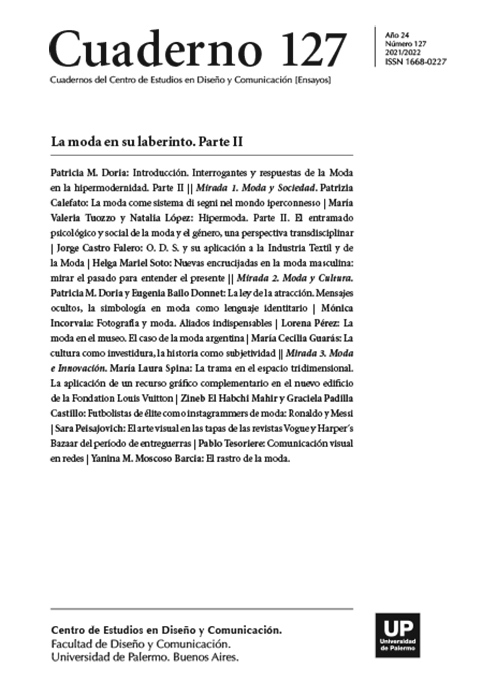La cultura como investidura, la historia como subjetividad
Abstract
This article seeks to reflect on the construction of the personal clothing narrative, based on the reconstruction of the inherited family history. Parallelize the memory and the tangible material by putting them in dialogue in a different context from the event itself, updated through a contemporary receiver. It seeks, in turn, to reflect on the superposition of temporalities that are embodied in memories and materialities, written in a timeline and told through written, material or spoken stories. This story heard in the stories, read in the letters and observed in the photographs, is transformed into an investiture that embraces the recipient, endowing him with meaning, containing him, dressing him and composing him beyond his contemporaneity. Based on this conceptualization, we seek to analyze clothing practice as a symbolic act that brings to a present time, a cultural heritage that is resignified from generation to generation. It is intended to analyze the concept of history / story as subjectivity reflecting on the symbolic reconstruction of what is understood as family culture. From stories, photographs and objects of daily use already separated from those who previously owned them, to delve into the emotional reconstruction of the story told of our ancestors, as someone who chooses a garment every day from their wardrobes, in this article will take up the echo of some stories that have survived for several generations. This article is built from the development of “Herencia”, an upcycled capsule of clothing made by the writer, on a journey in time and space towards family ancestors.
References
Baudelaire, C. (1863). Le peintre de la vie Moderne. Paris: Collection Litteratura.com.
Baudrillard, J. (1976). Symbolic Exchange and Death. Estados Unidos: SAGE Publications.
Bauman, Z. (1994). Pensando sociológicamente. Extracto de la Introducción: Sociología ¿Para qué? Buenos Aires: Nueva Visión.
Bourdieu, P. (1990). Sociología y cultura. Traducción de Matha Pou. México DF: Grijalbo.
Bourdieu, P. (1971). Elementos de una teoría sociológica de la percepción artística. Buenos Aires: Nueva Visión.
Didion, J. (2015). El año del pensamiento mágico. Estados Unidos: Literatura Random House.
Bourdieu, P. y Delsaut,Y. (1975). Le couturier et sa griffe: contribution à une théorie de la magie. In: Actes de la recherche en sciences sociales. Hiérarchie sociale des objets. 1, 7-34.
Entwistle, J. (2002). El cuerpo y la moda, una visión sociológica. Barcelona: Paidós.
Flügel, J. (1930). The psychology of clothes (1930). New York: AMS press.
García Canclini, N. (2001). Las culturas híbridas en tiempos globalizados en: Culturas Híbridas. Buenos Aires: Paidós.
García Martinez, J. (2017). El habitus. Una revisión analítica. Córdoba: Revista Internacional de Sociología.
González Villarruel, A. (2010). La vida social de los objetos etnográficos y su desalmada mercantilización. México DF: Alteridades.
Guaras, M. C. (2020). Campaña de comunicación Heritage. Buenos Aires.
Habermas, J. (1989) El discurso filosófico de la modernidad. Madrid: Taurus.
Heidegger, M. (1927). Ser y tiempo. 2da, Parte. trad. por Jorge Eduardo Rivera. Santiago de Chile: Editorial Universitaria.
Jakobson, R. (1984). Lingüística y poética. Ensayos de lingüística general. Barcelona: Ariel.
Polhemus, T. (1978). Fashion & Anti-Fashion. Londres: Thames and Hudson.
Sartre, J. (1993). Being and nothingness. Washington: Square Press.
Tusón-Valls, J. (2003). Introducción al lenguaje. Barcelona: Ariel.
Veneziani, M. (2014). Escritos en la Facultad N°95. Buenos Aires: Universidad de Palermo.
Wilson, E. (1985). Adorned in Dreams: Fashion and Modernity. Nueva York: I.B. Tauris.
Los autores/as que publiquen en esta revista ceden los derechos de autor y de publicación a "Cuadernos del Centro de Estudios de Diseño y Comunicación", Aceptando el registro de su trabajo bajo una licencia de atribución de Creative Commons, que permite a terceros utilizar lo publicado siempre que de el crédito pertinente a los autores y a esta revista.


